Spatial Interaction and Driving Factors between Urban Land Expansion and Population Change in China
Abstract
1. Introduction
2. Materials and Methodology
2.1. Gravity Model
2.2. Defining a New Interaction Coefficient
| Urban Hierarchy | Urban Population Scale (Ten Thousands of People) | Ideal Value of per Capita Land Use (m2/person) | ||
|---|---|---|---|---|
| Previous Research | I, II, VI and VII Climatic Zone for Architecture | III, IV and V Climatic Zone for Architecture | ||
| Megacities | ≥1000 | 95 | 95 | 90 |
| Supercities | (500–1000) | 95 | 95 | 90 |
| Large cities | (100–500) | 100 | 100 | 95 |
| Medium cities | (50–100) | 105 | 105 | 100 |
| Small cities | <50 | 110 | 110 | 105 |
2.3. The Geographical Detector Method
2.3.1. Factor Detector
2.3.2. Interaction Detector
2.4. Data Sources and Pre-Processing
3. Results
3.1. Overall Situation of Interaction between Urban Land Expansion and Population Change
3.1.1. Staged Transformation of Urban Land Expansion and Population Change
3.1.2. Spatial Mismatch between Urban Land and Population
3.2. Spatiotemporal Interaction Types between Urban Land Expansion and Population Change
3.2.1. Spatial Pattern Characteristics of Interaction Types
- (1)
- Rapid land expansion type. This includes 257 cities, accounting for 41.83% of the land and 35.67% of the population in China’s cities. Both the urban land and population are increasing, but the urban land expansion is 2.44 times the population growth rate, and the per capita construction land will increase from 96.04 m2 in 2006 to 157.79 m2 in 2021. They are mostly distributed in the periphery of urban agglomerations such as the Beijing–Tianjin–Hebei region and the Yangtze River Delta region, and in rapidly developing urban agglomerations such as the Central Plains City cluster and the middle reaches of the Yangtze River.
- (2)
- Coordinated development type. This type accounts for 24.92% of the number of cities in China, and the ICLP is between 0.9 and 1.3, which shows the coordinated growth of urban land and population. The per capita land area increased from 114.35 m2 in 2006 to 135.04 m2 in 2021. Such cities are mainly distributed in eastern and central China, represented by Hangzhou, Ningbo, Suzhou and Xuzhou in the Yangtze River Delta, and Tianjin, Shijiazhuang and Langfang in North China.
- (3)
- Rapid population growth type. This type has only 52 cities and an ICLP between 0 and 0.9. Such cities are mainly exemplified by Beijing, Shenzhen, Zhuhai and other big cities. Population growth in these cities is significantly faster than the rate of land expansion, with the per capita land falling from 116.21 m2 in 2006 to 91.96 m2 in 2021.
- (4)
- Shrinking city type. This city type manifests as urban population shrinkage or land shrinkage, which can be divided into three subcategories: the land shrinkage and population growth type, the land shrinkage and population shrinkage type and the land expansion and population shrinkage type. These are also known as shrinking cities. Cities with land shrinkage and population growth have a declining land consumption level, belonging to the category of actively shrinkage cities. However, there are only 18 cities of this type, such as Shanghai, Fuzhou and Haikou. The land shrinkage and population shrinkage type, and land expansion and population shrinkage type belong to negatively shrinkage cities. There are 19 cities with land shrinkage and population shrinkage, mainly distributed in Northeast China, Gansu, Inner Mongolia and Hubei, most of which are county-level cities or resource-based cities. There is relatively more land expansion and population shrinkage in cities, numbering up to 118. These cities are characterised by an uncoordinated state where the population decreases while the land increases. This type of city has obvious spatial agglomeration characteristics, with 51 cities located in Northeast China, and the rest mainly located on the periphery of urban agglomerations such as Beijing–Tianjin–Hebei, the Yangtze River Delta, the middle reaches of the Yangtze River and Chengdu–Chongqing.
3.2.2. Different Scale Cities’ Interaction Types
- There are five megacities, namely, Shanghai (land shrinkage and population growth type), Beijing, Shenzhen (rapid population growth type), Chongqing and Tianjin (coordinated development type). In China’s urbanisation strategy, the size of megacities is strictly controlled. Under the dual reinforcement of fewer new construction land indicators and greater population attraction, the land consumption level of the megacities has declined further.
- There are 15 megacities, mainly of the coordinated development type, supplemented by the land rapid expansion type. Four cities, Hangzhou, Changsha, Chengdu and Xi’an exhibit coordinated urban land and population, with the per capita land increasing from 94.11 m2 in 2006 to 108.57 m2 in 2021. Nanjing, Wuhan and Guangzhou exhibit land expansion, with the per capita land increasing from 73.29 m2 in 2006 to 165.19 m2 in 2021, a growth rate of 2.25 times, indicating a significant land expansion characteristic.
- There are 75 large cities, accounting for 35.16% of the urban land nationwide and supporting 32.01% of the population. The per capita land is 147.81 m2, higher than the national average of 134.54 m2. These cities mainly exhibit two types of rapid land expansion and coordinated development. In 2006, the per capita land of the rapid land expansion type of cities was 90.75 m2, with a small base that was only 73.36% of the coordinated development type of cities. However, the growth rate of land was 2.48 times higher than the latter. In 2021, the per capita land of the two types of cities was 142.79 m2 and 152.36 m2, respectively, and therefore almost at the same level.
- Small and medium-sized cities. Small and medium-sized cities are primarily of the rapid land expansion type, accounting for 41.62%. It is worth noting that 21.28% of these cities, while experiencing population outflow, have increased rather than decreased their urban land, exhibiting a low-density development trend. This has exacerbated the already acute contradiction between farmland protection and urban land expansion.
3.2.3. Comparison of IULP before and after the New-Type Urbanisation
3.3. Driving Factors of Interaction between Urban Land Expansion and Population Change
3.3.1. Factor Detector Results
3.3.2. Interaction Detector Results
4. Discussion
4.1. The Spatial Interaction between Urban Land Expansion and Population Change
4.2. The Driving Mechanism of Interaction between Urban Land Expansion and Population Change
4.3. Policy Implications
5. Conclusions
- (1)
- From 2006 to 2021, China’s urban land expansion rate was 1.83 times that of population growth, confirming the traditional consensus that land expansion is significantly faster than population growth. The rising level of land consumption may be an obstacle to the sustainable development of Chinese cities. However, the stages of this consensus are obvious; especially before and after China implemented the New-type Urbanisation Plan in 2014, the rate of urban land expansion/population growth dropped from 2.46 to 1.12. The urban character of rapid land expansion has been curbed.
- (2)
- It was found that the peripheral cities of urban agglomerations such as Beijing–Tianjin–Hebei and the Yangtze River Delta show the characteristics of rapid land expansion. The rapid development of urban agglomerations in the middle reaches of the Yangtze River, Chengdu–Chongqing and Harbin–Dalian–Changchun are mostly characterised by land expansion and population shrinkage.
- (3)
- The GDM results showed that multiple factors such as urban development rights, economic aspects, resources and the environment work together, leading to an increase in the land consumption level. Fortunately, after the implementation of the New-type Urbanisation Plan, the development of Chinese cities gradually eliminated inefficient policy intervention, and market mechanisms and resource and environmental constraints have gradually become the dominant factors in urban land expansion and population change.
Author Contributions
Funding
Informed Consent Statement
Data Availability Statement
Conflicts of Interest
References
- Schmidt-Traub, G.; Kroll, C.; Teksoz, K.; Durand-Delacre, D.; Sachs, J.D. National baselines for the Sustainable Development Goals assessed in the SDG Index and Dashboards. Nat. Geosci. 2017, 10, 547–555. [Google Scholar] [CrossRef]
- Rusadi, E.Y.; Habitat, U.N. World Cities Report 2022. Available online: https://unhabitat.org/wcr/ (accessed on 5 July 2024).
- Jiang, H.; Sun, Z.; Guo, H.; Weng, Q.; Du, W.; Xing, Q.; Cai, G. An assessment of urbanization sustainability in China between 1990 and 2015 using land use efficiency indicators. Npj Urban Sustain. 2021, 1, 34. [Google Scholar] [CrossRef]
- Bai, X.; Shi, P.; Liu, Y. Society: Realizing China’s urban dream. Nature 2014, 509, 158–160. [Google Scholar] [CrossRef]
- Mishra, A.; Humpenöder, F.; Churkina, G.; Reyer, C.P.O.; Beier, F.; Bodirsky, B.L.; Schellnhuber, H.J.; Lotze-Campen, H.; Popp, A. Land use change and carbon emissions of a transformation to timber cities. Nat. Commun. 2022, 13, 4889. [Google Scholar] [CrossRef]
- Ren, Q.; He, C.Y.; Huang, Q.X.; Shi, P.J.; Zhang, D.; Güneralp, B. Impacts of urban expansion on natural habitats in global drylands. Nat. Sustain. 2022, 5, 869–878. [Google Scholar] [CrossRef]
- Yang, D.; Luan, W.-X.; Zhang, X. Projecting spatial interactions between global population and land use changes in the 21st century. Npj Urban Sustain. 2023, 3, 53. [Google Scholar] [CrossRef]
- Chen, Z.; Tang, J.; Wan, J.; Chen, Y. Promotion incentives for local officials and the expansion of urban construction land in China: Using the Yangtze River Delta as a case study. Land Use Policy 2017, 63, 214–225. [Google Scholar] [CrossRef]
- Xu, G.; Jiao, L.; Yuan, M.; Dong, T.; Zhang, B.; Du, C. How does urban population density decline over time? An exponential model for Chinese cities with international comparisons. Landsc. Urban Plan. 2019, 183, 59–67. [Google Scholar] [CrossRef]
- Güneralp, B.; Reba, M.; Hales, B.U.; Wentz, E.A.; Seto, K.C. Trends in urban land expansion, density, and land transitions from 1970 to 2010: A global synthesis. Environ. Res. Lett. 2020, 15, 044015. [Google Scholar] [CrossRef]
- Marshall, J.D. Urban land area and population growth: A new scaling relationship for metropolitan expansion. Urban. Stud. 2007, 44, 1889–1904. [Google Scholar] [CrossRef]
- Chen, M.; Liu, W.; Lu, D. Challenges and the way forward in China’s new-type urbanization. Land Use Policy 2016, 55, 334–339. [Google Scholar] [CrossRef]
- Li, C.; Zhao, J.; Xu, Y. Examining spatiotemporally varying effects of urban expansion and the underlying driving factors. Sustain. Cities Soc. 2017, 28, 307–320. [Google Scholar] [CrossRef]
- Central People’s Government of the People’s Republic of China. Central Committee of the Communist Party of China and the State Council. Available online: https://www.gov.cn/zhengce/2014-03/16/content_2640075.htm (accessed on 5 July 2024).
- Xiong, C.; Cai, J. Facts and reflections on the relationship between population urbanization and land urbanization in China. Hebei Acad. J. 2021, 41, 146–156. (In Chinese) [Google Scholar]
- Angel, S.; Parent, J.; Civco, D.L.; Blei, A.M. Atlas of Urban Expansion; Lincoln Institute of Land Policy: Cambridge, UK, 2012. [Google Scholar]
- Chen, J.; Zhao, D.; Kang, M.-L. Urban Land Expansion, Interior Spatial Population Distribution, and Urban Economic Growth: Evidence from China. Emerg. Mark. Financ. Trade 2023, 59, 27–38. [Google Scholar] [CrossRef]
- Zhang, J.; Wang, Y.; Ge, Y. Evaluating the Relationship between Urban Population Growth and Land Expansion from a Policymaking Perspective: Ningbo, China. J. Urban Plan. Dev. 2020, 146, 04020045. [Google Scholar] [CrossRef]
- Li, Z.; Luan, W.; Zhang, Z.; Su, M. Relationship between urban construction land expansion and population/economic growth in Liaoning Province, China. Land Use Policy 2020, 99, 105022. [Google Scholar] [CrossRef]
- Jiang, S.; Zhang, Z.; Ren, H.; Wei, G.; Xu, M.; Liu, B. Spatiotemporal Characteristics of Urban Land Expansion and Population Growth in Africa from 2001 to 2019: Evidence from Population Density Data. Isprs Int. J. Geo-Inf. 2021, 10, 584. [Google Scholar] [CrossRef]
- Zang, Y.Z.; Zhu, J.J.; Han, X.; Lv, L.G. Dynamics between Population Growth and Construction Land Expansion: Evidence from the Yangtze River Economic Belt of China. Land 2023, 12, 1288. [Google Scholar] [CrossRef]
- Song, W.; Cao, S.; Du, M.; Lu, L. Distinctive roles of land-use efficiency in sustainable development goals: An investigation of trade-offs and synergies in China. J. Clean. Prod. 2023, 382, 134889. [Google Scholar] [CrossRef]
- Yan, Z.; Xianjin, H.; Guoliang, X.; Jianbao, L. The coupling and driving forces between urban land expansion and population growth in Yangtze River Delta. Geogr. Res. 2016, 35, 313–324. [Google Scholar] [CrossRef]
- Wu, Y.; Liu, Y.; Yurui, L. Spatio-temporal coupling of demographic-landscape urbanization and its driving forces in China. Acta Geogr. Sin. 2018, 73, 1865–1879. [Google Scholar] [CrossRef]
- Hasse, J.E.; Lathrop, R.G. Land resource impact indicators of urban sprawl. Appl. Geogr. 2003, 23, 159–175. [Google Scholar] [CrossRef]
- He, C.; Chen, T.; Mao, X.; Zhou, Y. Economic transition, urbanization and population redistribution in China. Habitat Int. 2016, 51, 39–47. [Google Scholar] [CrossRef]
- Wang, X.-R.; Hui, E.C.-M.; Choguill, C.; Jia, S.-H. The new urbanization policy in China: Which way forward? Habitat Int. 2015, 47, 279–284. [Google Scholar] [CrossRef]
- Friedmann, J. Four Theses in the Study of China’s Urbanization. Int. J. Urban Reg. Res. 2006, 30, 440–451. [Google Scholar] [CrossRef]
- Cai, Z.Y.; Liu, Q.; Cao, S.X. Real estate supports rapid development of China’s urbanization. Land Use Policy 2020, 95, 104582. [Google Scholar] [CrossRef]
- Zhou, Y.; Kong, Y.; Wang, H.K.; Luo, F.Y. The impact of population urbanization lag on eco-efficiency: A panel quantile approach. J. Clean. Prod. 2020, 244, 118664. [Google Scholar] [CrossRef]
- Zhang, G.L.; Zhang, N.; Liao, W.M. How do population and land urbanization affect CO2 emissions under gravity center change? A spatial econometric analysis. J. Clean. Prod. 2018, 202, 510–523. [Google Scholar] [CrossRef]
- McKee, J.J.; Rose, A.N.; Bright, E.A.; Huynh, T.; Bhaduri, B.L. Locally adaptive, spatially explicit projection of US population for 2030 and 2050. Proc. Natl. Acad. Sci. USA 2015, 112, 1344–1349. [Google Scholar] [CrossRef]
- Yang, Q.; He, L.H. Spatiotemporal changes in population distribution and socioeconomic development in China from 1950 to 2010. Arab. J. Geosci. 2017, 10, 498. [Google Scholar] [CrossRef]
- Kandogan, Y. Globalization and Shifting Economic Centers of Gravity. Thunderbird Int. Bus. Rev. 2014, 56, 261–271. [Google Scholar] [CrossRef]
- Liu, G.Y.; Yang, Z.F.; Fath, B.D.; Shi, L.; Ulgiati, S. Time and space model of urban pollution migration: Economy-energy-environment nexus network. Appl. Energy 2017, 186, 96–114. [Google Scholar] [CrossRef]
- You, Z.; Zhao, T.; Song, C.; Wang, J. Analyzing China’s coal-related carbon emissions from economic growth perspective: Through decoupling and decomposition model. Environ. Sci. Pollut. Res. 2021, 28, 3703–3718. [Google Scholar] [CrossRef] [PubMed]
- Jie, F.; Anjun, T.; Chen, L. The Coupling Mechanism of the Centroids of Economic Gravity and Population Gravity and Its Effect on the Regional Gap in China. Prog. Geogr. 2010, 29, 87–95. (In Chinese) [Google Scholar]
- Li, Z.; Chen, B.; Wu, S.; Su, M.; Chen, J.M.; Xu, B. Deep learning for urban land use category classification: A review and experimental assessment. Remote Sens. Environ. 2024, 311, 114290. [Google Scholar] [CrossRef]
- Khoukhi, M.; Gomez, A.M.; Al Kaabi, S.; Shbeikat, W.; Amairi, H. Investigating the daylight levels for functional needs in UAE forts. Cogent Eng. 2020, 7, 1745554. [Google Scholar] [CrossRef]
- Jia, Y.; Liu, Z.; Fang, Y.; Zhang, H.; Zhao, C.; Cai, X. Effect of Interior Space and Window Geometry on Daylighting Performance for Terrace Classrooms of Universities in Severe Cold Regions: A Case Study of Shenyang, China. Buildings 2023, 13, 603. [Google Scholar] [CrossRef]
- Yanzhao, Y.; Zhiming, F.; Yande, Z.; Zhen, Y. Coordination between urban land expansion and population growth in China. Geogr. Res. 2013, 32, 1668–1678. [Google Scholar] [CrossRef]
- Wang, J.F.; Li, X.H.; Christakos, G.; Liao, Y.L.; Zhang, T.; Gu, X.; Zheng, X.Y. Geographical Detectors-Based Health Risk Assessment and its Application in the Neural Tube Defects Study of the Heshun Region, China. Int. J. Geogr. Inf. Sci. 2010, 24, 107–127. [Google Scholar] [CrossRef]
- Chang, L.; Li, Y.; Zhang, K.Y.; Zhang, J.L.; Li, Y.F. Temporal and Spatial Variation in Vegetation and Its Influencing Factors in the Songliao River Basin, China. Land 2023, 12, 1692. [Google Scholar] [CrossRef]
- Dong, J.; Li, X.P. Lead pollution-related health of children in China: Disparity, challenge, and policy. Sci. Total Environ. 2023, 882, 163383. [Google Scholar] [CrossRef]
- Zhou, Y.; Lu, Y. Spatiotemporal evolution and determinants of urban land use efficiency under green development orientation: Insights from 284 cities and eight economic zones in China, 2005–2019. Appl. Geogr. 2023, 161, 103117. [Google Scholar] [CrossRef]
- Wang, J.F.; Zhang, T.L.; Fu, B.J. A measure of spatial stratified heterogeneity. Ecol. Indic. 2016, 67, 250–256. [Google Scholar] [CrossRef]
- Liu, X.; Wang, H.; Wang, X.; Bai, M.; He, D. Driving factors and their interactions of carabid beetle distribution based on the geographical detector method. Ecol. Indic. 2021, 133, 108393. [Google Scholar] [CrossRef]
- Zhang, X.L.; Zhao, Y. Identification of the driving factors’ influences on regional energy-related carbon emissions in China based on geographical detector method. Environ. Sci. Pollut. Res. 2018, 25, 9626–9635. [Google Scholar] [CrossRef]
- Zhou, Y.; Huang, X.J.; Chen, Y.; Zhong, T.Y.; Xu, G.L.; He, J.L.; Xu, Y.T.; Meng, H. The effect of land use planning (2006–2020) on construction land growth in China. Cities 2017, 68, 37–47. [Google Scholar] [CrossRef]
- Li, Y.J.; Kong, X.S.; Zhu, Z.Q. Multiscale analysis of the correlation patterns between the urban population and construction land in China. Sustain. Cities Soc. 2020, 61, 12. [Google Scholar] [CrossRef]
- Yang, L.; Chen, W.; Fang, C.; Zeng, J. How does the coordinated development of population urbanization and land urbanization affect residents’ living standards? Empirical evidence from China. Cities 2024, 149, 104922. [Google Scholar] [CrossRef]
- Chen, M.; Gong, Y.; Lu, D.; Ye, C. Build a people-oriented urbanization: China’s new-type urbanization dream and Anhui model. Land Use Policy 2019, 80, 1–9. [Google Scholar] [CrossRef]
- Chan, K.W. Migration and development in China: Trends, geography and current issues. Migr. Dev. 2012, 1, 187–205. [Google Scholar] [CrossRef]
- Shi, L.; Wurm, M.; Huang, X.; Zhong, T.; Leichtle, T.; Taubenböck, H. Urbanization that hides in the dark—Spotting China’s “ghost neighborhoods” from space. Landsc. Urban Plan. 2020, 200, 103822. [Google Scholar] [CrossRef]
- Zhang, Y.P. Grabbing Land for Equitable Development? Reengineering Land Dispossession through Securitising Land Development Rights in Chongqing. Antipode 2018, 50, 1120–1140. [Google Scholar] [CrossRef]
- Ding, Y.; McQuoid, A.; Karayalcin, C. Fiscal decentralization, fiscal reform, and economic growth in china. China Econ. Rev. 2019, 53, 152–167. [Google Scholar] [CrossRef]
- Pu, Y.; Han, X.; Chi, G.; Wang, Y.; Ge, Y.; Kong, F. The impact of spatial spillovers on interprovincial migration in China, 2005–2010. Reg. Stud. 2019, 53, 1125–1136. [Google Scholar] [CrossRef]
- Wang, Y.; Dong, L.; Liu, Y.; Huang, Z.; Liu, Y. Migration patterns in China extracted from mobile positioning data. Habitat Int. 2019, 86, 71–80. [Google Scholar] [CrossRef]
- Sun, Y.; Wang, Y.; Zhou, X.; Chen, W. Are shrinking populations stifling urban resilience? Evidence from 111 resource-based cities in China. Cities 2023, 141, 104458. [Google Scholar] [CrossRef]
- Meng, H.; Huang, X.; Mao, X.; Xia, Y.; Lin, B.; Zhou, Y. The formation and proximity mechanism of population flow networks under multiple traffic in China. Cities 2023, 136, 104211. [Google Scholar] [CrossRef]
- Wu, Y.; Wang, L.; Fan, L.; Yang, M.; Zhang, Y.; Feng, Y. Comparison of the spatiotemporal mobility patterns among typical subgroups of the actual population with mobile phone data: A case study of Beijing. Cities 2020, 100, 102670. [Google Scholar] [CrossRef]
- Shen, J. Explaining Interregional Migration Changes in China, 1985–2000, Using a Decomposition Approach. Reg. Stud. 2015, 49, 1176–1192. [Google Scholar] [CrossRef]
- Xu, Y.; Song, Y.; Cai, J.; Zhu, H. Population mapping in China with Tencent social user and remote sensing data. Appl. Geogr. 2021, 130, 10245. [Google Scholar] [CrossRef]
- Li, C.; Wu, Z.; Zhu, L.; Liu, L.; Zhang, C. Changes of Spatiotemporal Pattern and Network Characteristic in Population Flow under COVID-19 Epidemic. Isprs Int. J. Geo-Inf. 2021, 10, 145. [Google Scholar] [CrossRef]
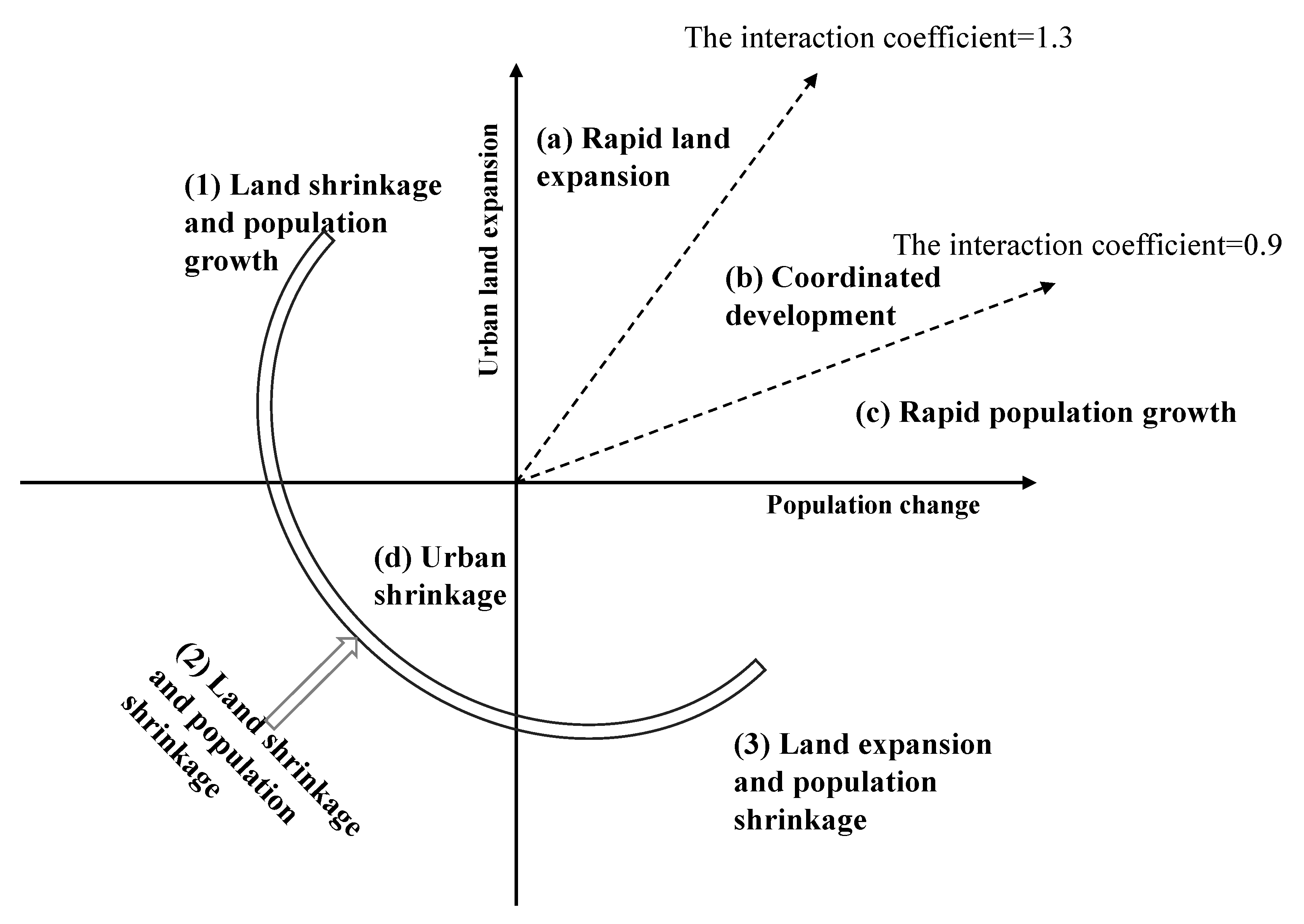
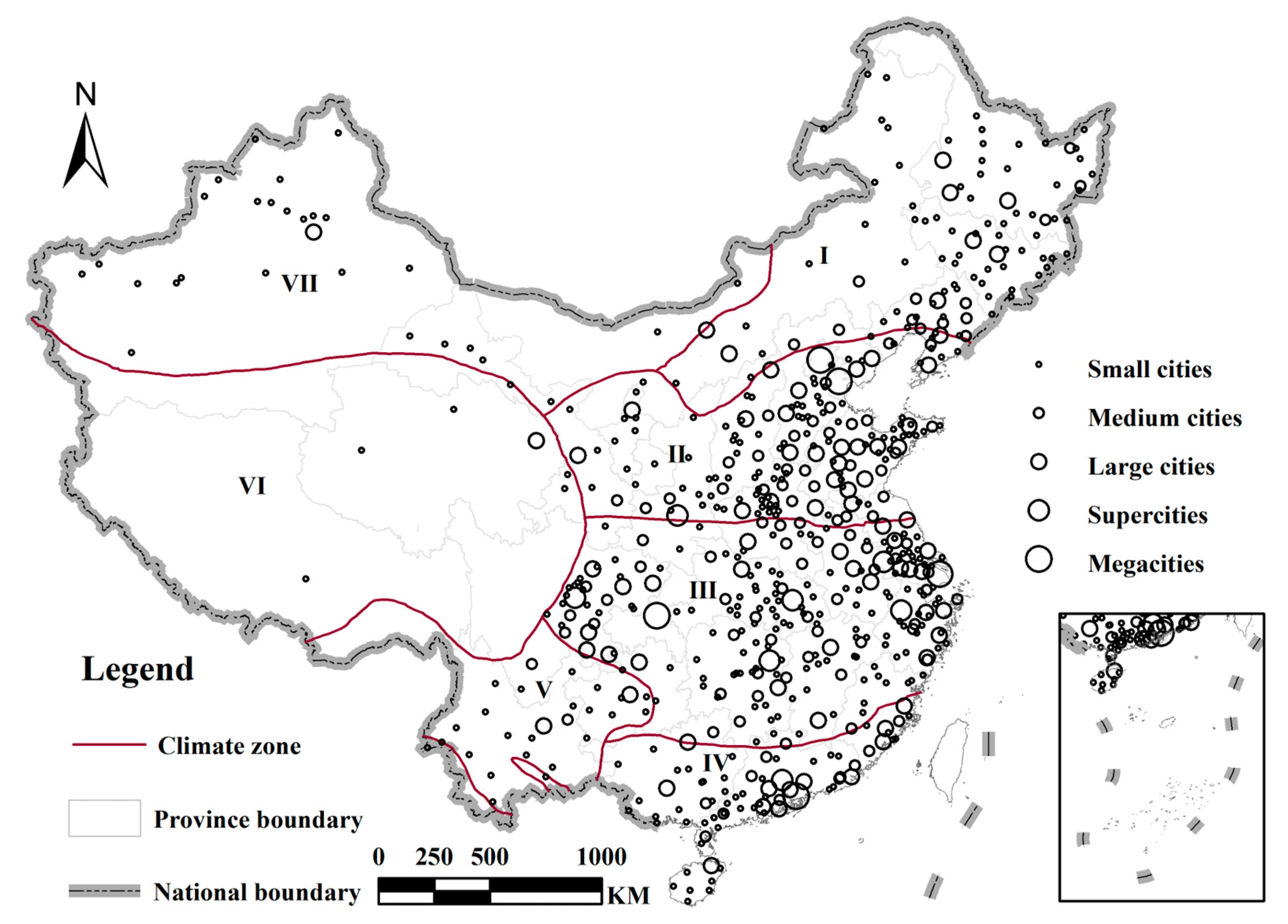
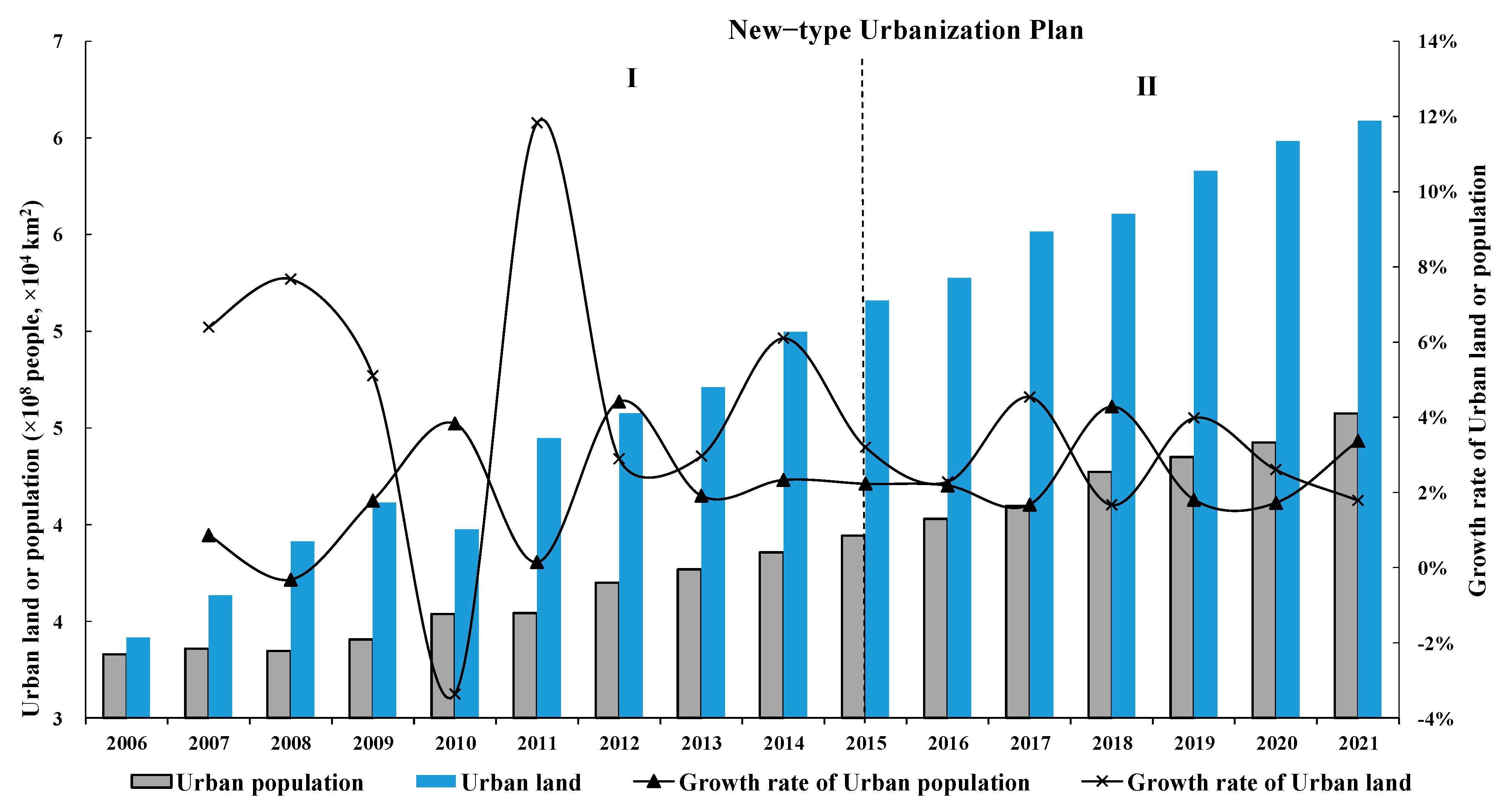

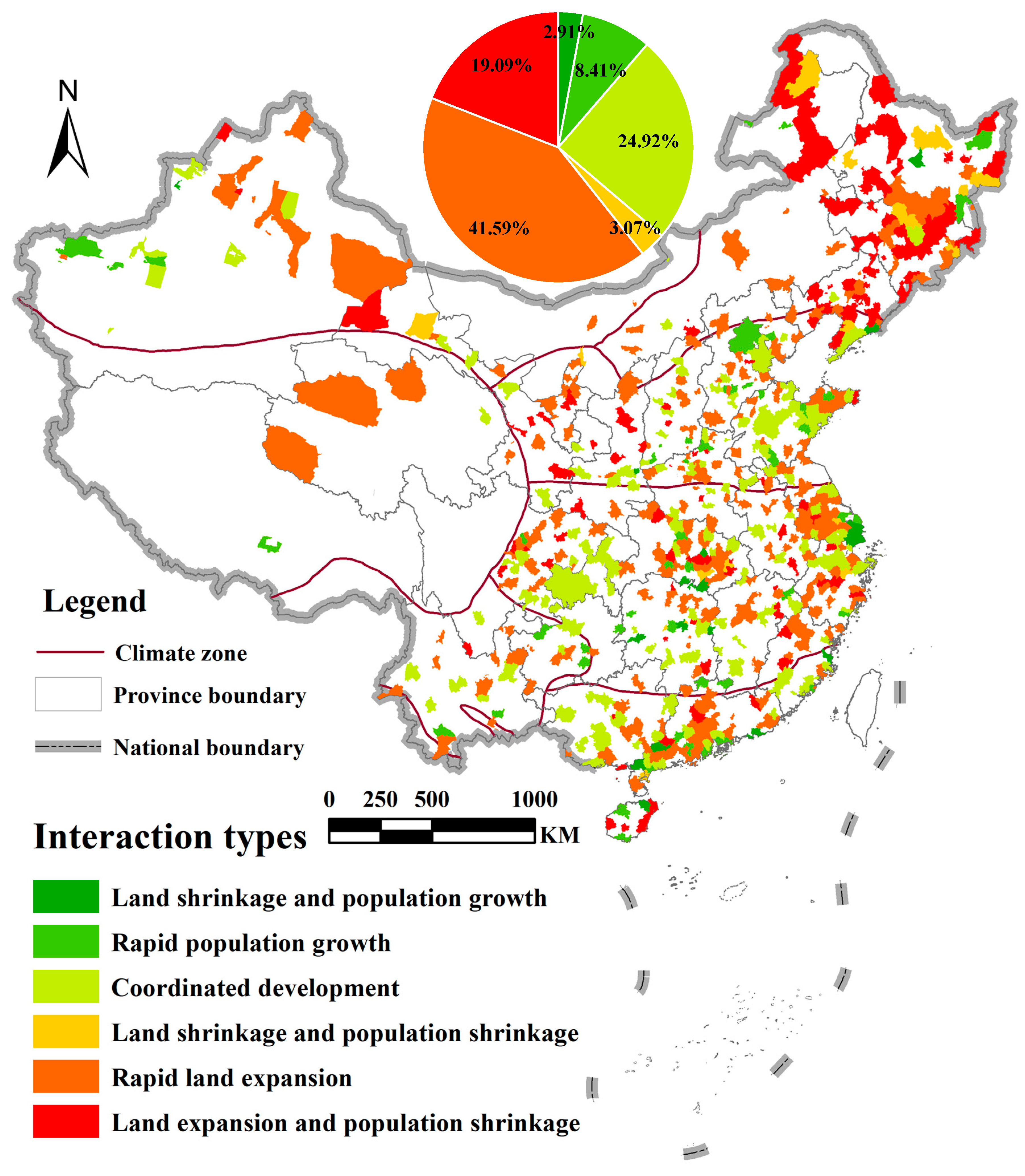
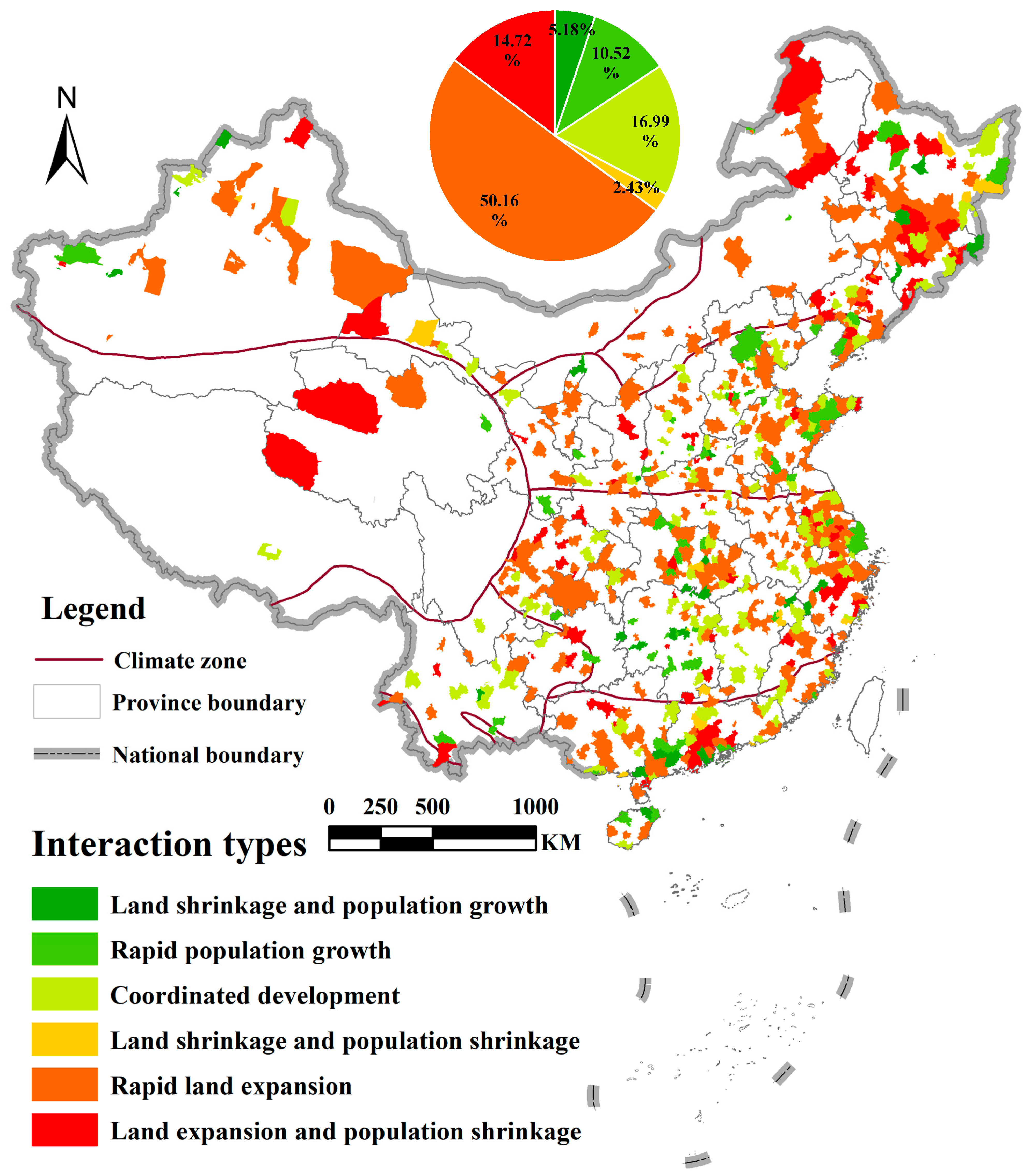
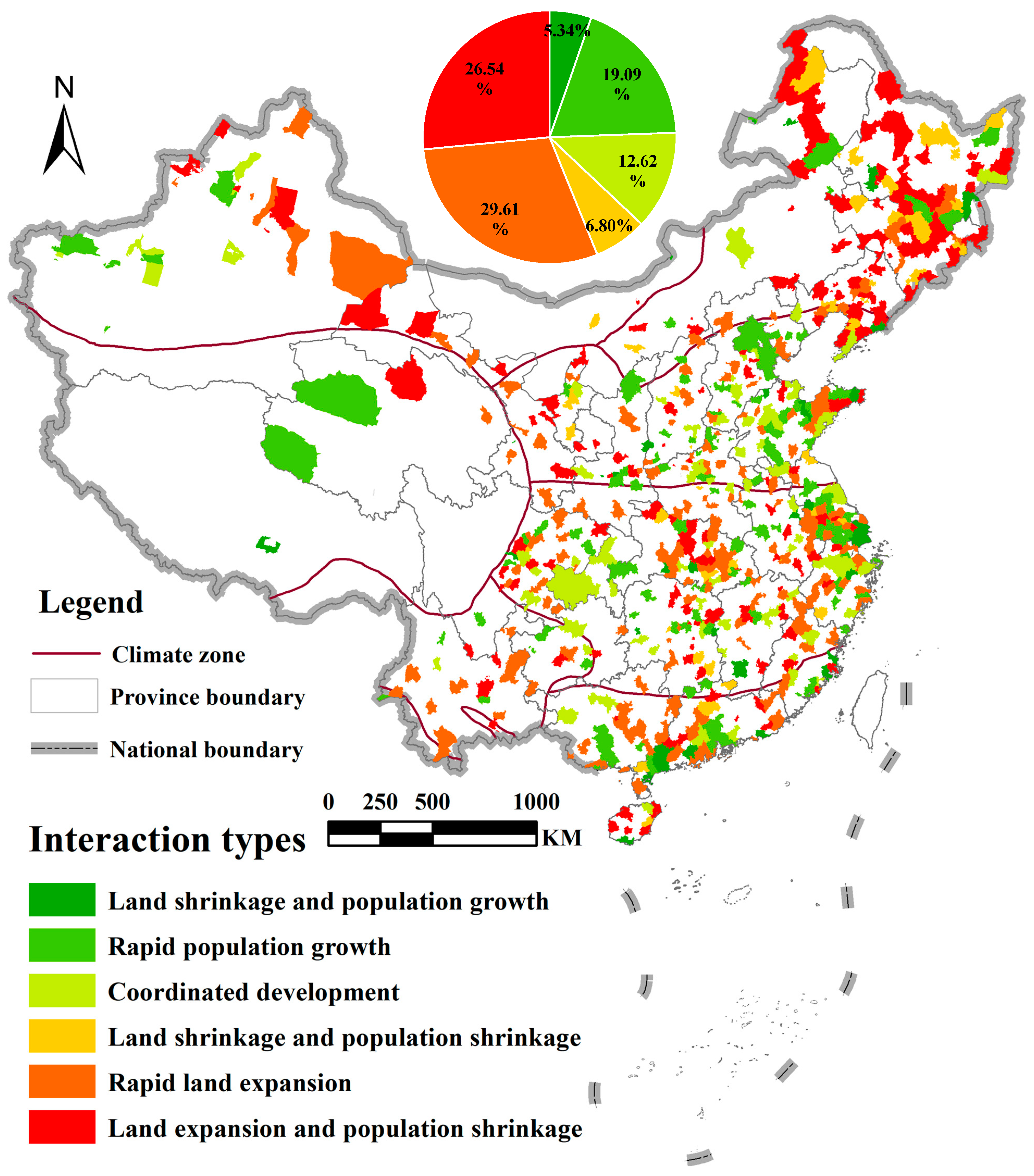
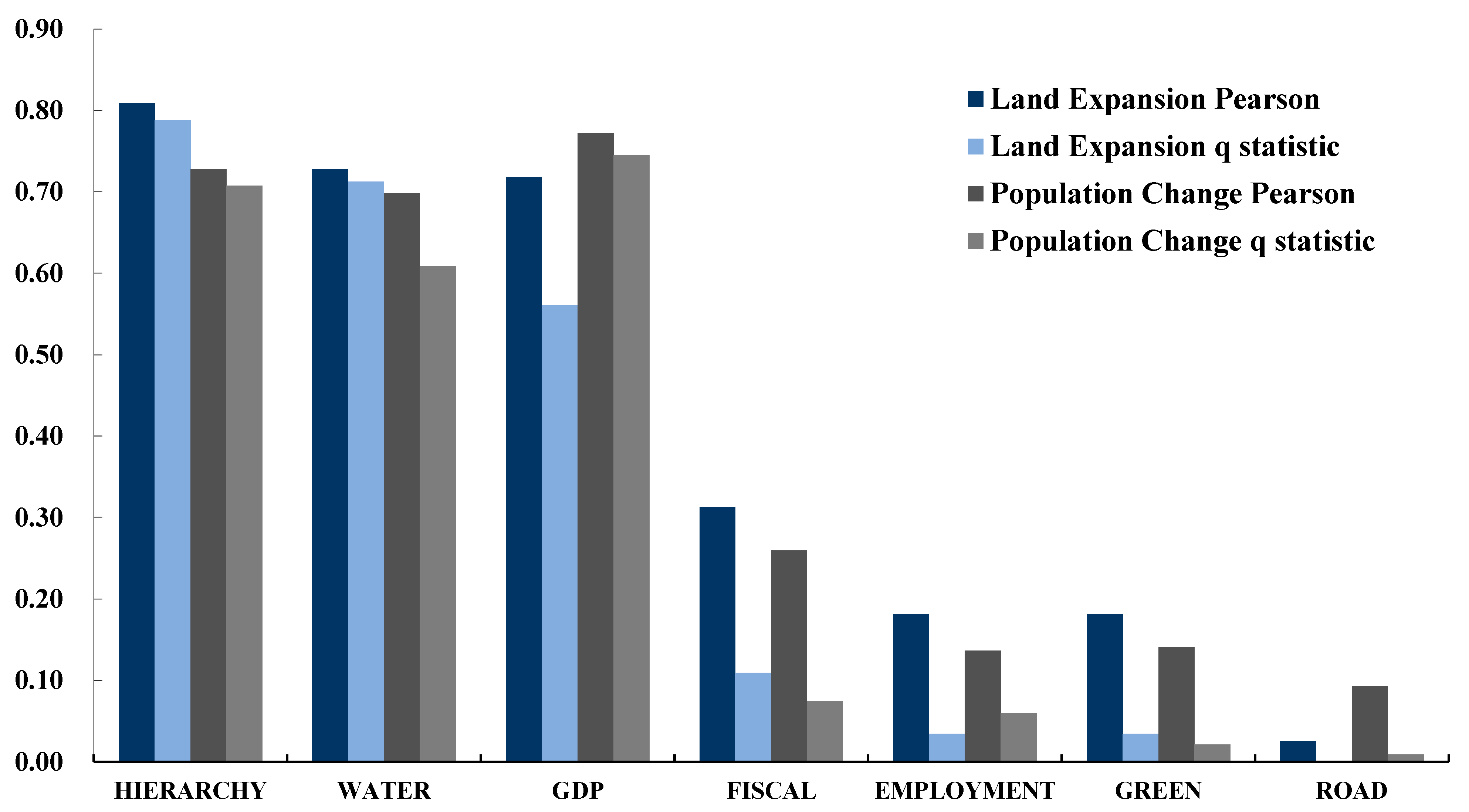
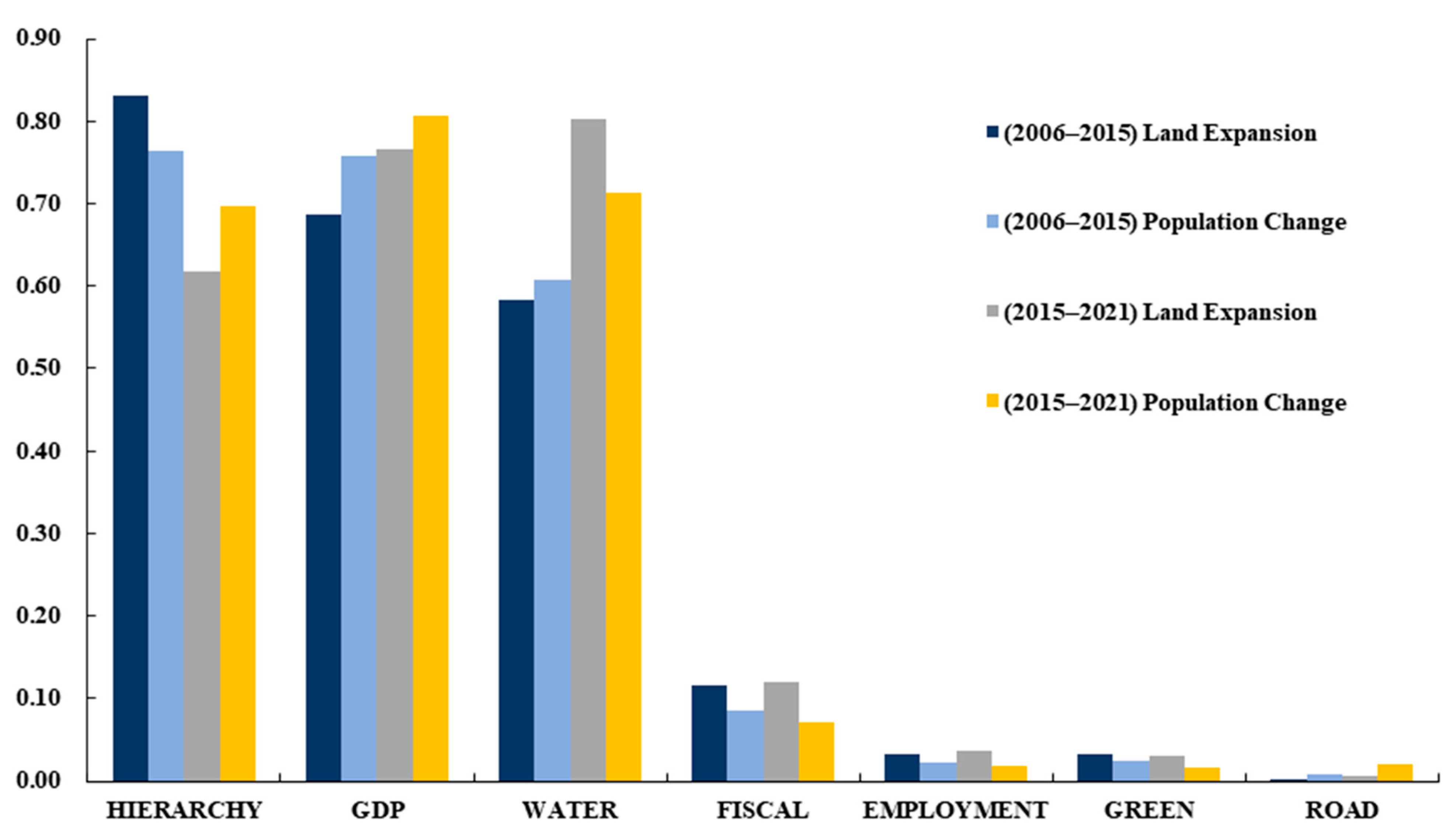
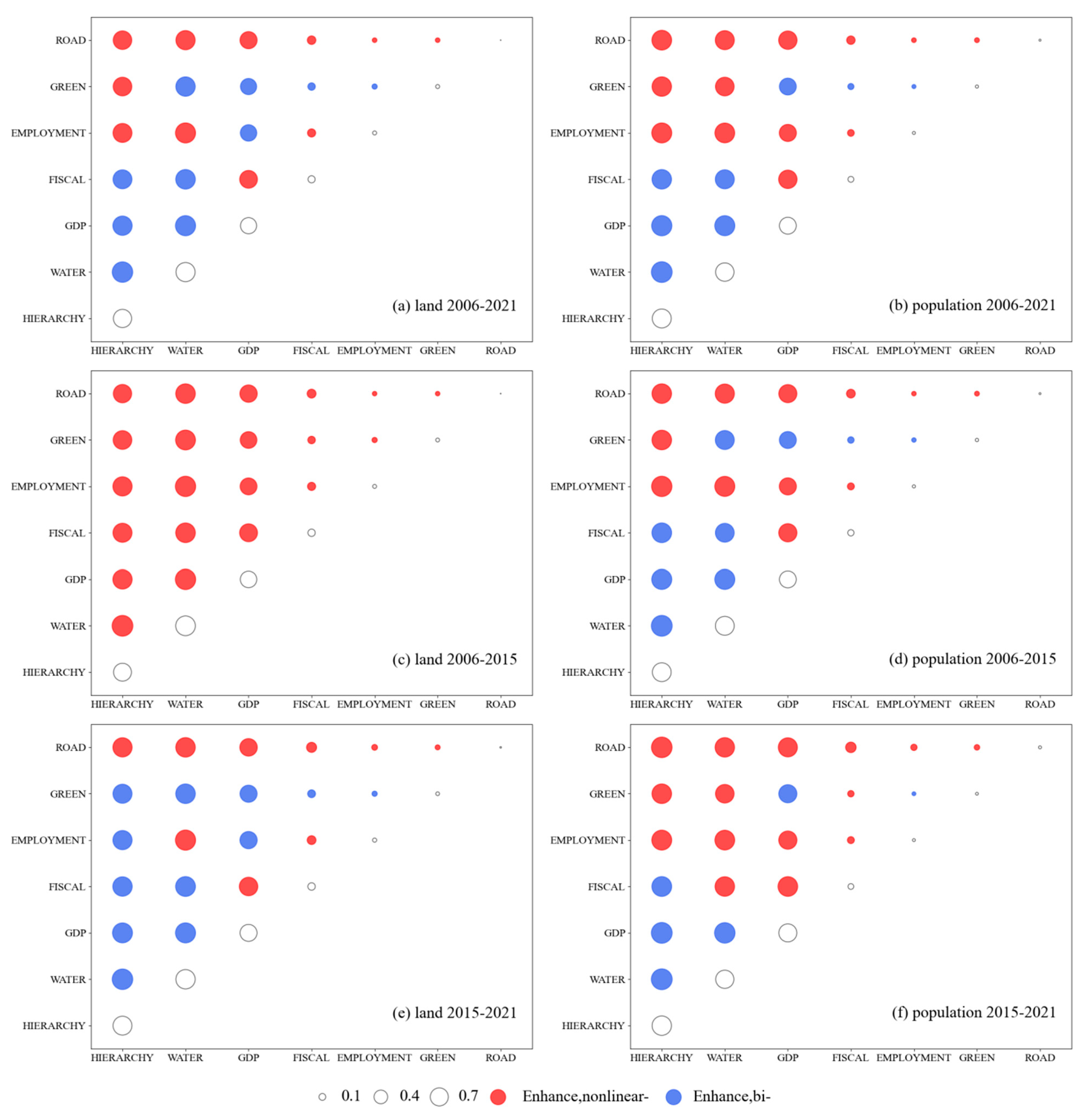
| Graphical Representation | Description | Interaction Categories |
|---|---|---|
 | Non-linearly weaken | |
 | Un-weaken | |
 | Bi-enhance | |
 | Independent | |
 | Non-linearly enhance |
 : ,
: ,  : ,
: ,  : ,
: ,  : .
: .| Interaction Types | Megacities | Supercities | Large Cities | Medium Cities | Small Cities |
|---|---|---|---|---|---|
| Rapid land expansion | / | 0.49% | 5.34% | 6.96% | 28.80% |
| Coordinated development | 0.32% | 0.65% | 5.02% | 5.18% | 13.75% |
| Rapid population growth | 0.32% | / | 0.49% | 0.32% | 7.28% |
| Land shrinkage and population growth | 0.16% | / | 0.32% | 0.32% | 2.10% |
| Land shrinkage and population shrinkage | / | / | 0.16% | 0.32% | 2.59% |
| Land expansion and population shrinkage | / | / | 0.81% | 3.07% | 15.21% |
Disclaimer/Publisher’s Note: The statements, opinions and data contained in all publications are solely those of the individual author(s) and contributor(s) and not of MDPI and/or the editor(s). MDPI and/or the editor(s) disclaim responsibility for any injury to people or property resulting from any ideas, methods, instructions or products referred to in the content. |
© 2024 by the authors. Licensee MDPI, Basel, Switzerland. This article is an open access article distributed under the terms and conditions of the Creative Commons Attribution (CC BY) license (https://creativecommons.org/licenses/by/4.0/).
Share and Cite
Meng, H.; Liu, Q.; Yang, J.; Li, J.; Chuai, X.; Huang, X. Spatial Interaction and Driving Factors between Urban Land Expansion and Population Change in China. Land 2024, 13, 1295. https://doi.org/10.3390/land13081295
Meng H, Liu Q, Yang J, Li J, Chuai X, Huang X. Spatial Interaction and Driving Factors between Urban Land Expansion and Population Change in China. Land. 2024; 13(8):1295. https://doi.org/10.3390/land13081295
Chicago/Turabian StyleMeng, Hao, Qianming Liu, Jun Yang, Jianbao Li, Xiaowei Chuai, and Xianjin Huang. 2024. "Spatial Interaction and Driving Factors between Urban Land Expansion and Population Change in China" Land 13, no. 8: 1295. https://doi.org/10.3390/land13081295
APA StyleMeng, H., Liu, Q., Yang, J., Li, J., Chuai, X., & Huang, X. (2024). Spatial Interaction and Driving Factors between Urban Land Expansion and Population Change in China. Land, 13(8), 1295. https://doi.org/10.3390/land13081295






